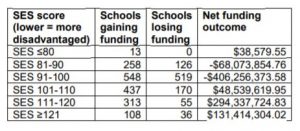Poor schools the big losers in Catholic funding campaign
Catholic schools in high-income areas would be the main winners – and Catholic and Independent schools in low-income areas would be the big losers – under changes to school funding proposed by Catholic education officials.
New modelling shows implementing the changes would have the opposite effect of the
purported aim – to properly fund disadvantaged non-government schools.
Instead, it would take close to half a billion dollars from more needy schools.
The Catholic Education Commission of Victoria (CECV) is waging an aggressive political
campaign to force changes in the way the Australian Government currently funds non-government schools, based on schools’ social economic status (SES).
Under current arrangements, the higher a school’s SES ranking, the lower the need of the
school community, and the less government funding it receives.
The CECV wants the SES model replaced with an ill-defined measure of the school’s income
based on the fees they charge.
But modelling by Independent Schools Victoria (ISV) shows the change would further
disadvantage poorer schools, and would benefit selected Catholic schools to the detriment
of less well-off Catholic and Independent schools.
‘This research undermines the central argument being propagated by the CECV, which
falsely claims to represent disadvantaged Catholic and other non-government schools,’ ISV
Chief Executive Michelle Green said.
‘The real aim of the political pressure being applied by the CECV is to allow Catholic
education authorities to prop up their schools in high income areas that currently charge
unrealistic low fees through subsidies ultimately paid by Australian taxpayers.
‘This is consistent with the internal operations of Catholic school authorities, who already
transfer funds from low-SES Catholic schools to schools in wealthier suburbs.’
The ISV modelling sought to determine the real impact on schools of replacing the SES
methodology with a measure of schools’ income based on their fees.
It shows the main impact of such a change would be to transfer money from low-SES schools
to high-SES schools. It would unfairly favour Catholic schools in established metropolitan
suburbs with high SES scores.
The schools that face the greatest losses would not, as CECV claims, be those that charge
the highest fees. Instead, they would be low-SES Catholic and Independent schools,
particularly in regional areas, and Independent schools in Melbourne and Sydney with midrange SES scores.
The modelling is based on the latest, publicly available data – 2016 private recurrent income
on the My School website, 2017 enrolments and SES scores.
It calculates what the results would be if the same amount of money that was currently
allocated to non-government schools based on their SES scores, was allocated based on
schools’ average private income per student, including fees.
Of the 100 schools across Australia that would receive the highest amount of additional
funding per student, 90 are Catholic schools and all 100 schools have an SES score of 118
or above – making them the least disadvantaged schools in Australia.
Below is a summary of the findings of ISV’s modelling. It shows that linking funding to fees,
rather than SES, results in money being taken out of disadvantaged schools (i.e. schools with
an SES below the national average of 100) and being provided to less needy schools.

Ms Green said: ‘ISV recognises that the SES methodology is not perfect, but we believe that
any changes should be based on the report of the independent review currently being
undertaken by the National Schools Resourcing Board.
‘Changes should not be based on heavy-handed political lobbying designed to unfairly favour
one school sector over another.’
Media contact
Tom Hyland
ISV Media and Communications Advisor
0417 562 924
tom.hyland@is.vic.edu.au